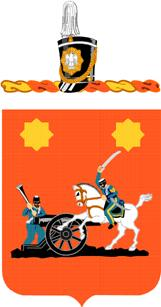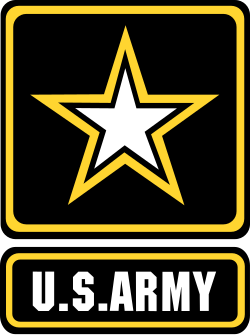2nd Cavalry Regiment (Vereinigte Staaten)

Das 2nd Cavalry Regiment (deutsch 2. US-Kavallerieregiment) ist ein Kavallerieregiment der US Army. Das Regiment ist der am längsten ununterbrochen bestehende Verband der US Army. Das Regiment hat sein Hauptquartier in den Rose Barracks in Vilseck (Deutschland).
Geschichte

Am 23. Mai 1836 wurde das 2. Dragonerregiment von US-Präsident Andrew Jackson aufgestellt. 1861 wurde das Regiment in 2nd US Cavalry, 1941 in 2nd Cavalry Group (mechanized), 1948 in 2nd Armored Cavalry Regiment und 2006 in 2nd Stryker Cavalry Regiment umbenannt. Mit der erneuten Umbenennung 2011 in 2nd Cavalry Regiment orientierte sich das Regiment wieder mehr an der Bezeichnung von 1861.[1]
Im Kalten Krieg war das Regiment ab 1952 im Rahmen des VII. Korps der 7. US-Armee für die Sicherung des Eisernen Vorhanges in Bayern im Grenzabschnitt zur DDR und zur CSSR verantwortlich. Sein Hauptquartier war in den Merrell Barracks in Nürnberg.
Am 8. November 1990 erhielt das VII. Korps den Befehl, an den Persischen Golf zu verlegen, um an den Operationen Desert Shield und Desert Storm zur Befreiung des vom Irak besetzten Kuwait teilzunehmen. Das 2ACR war als erste Einheit des Korps ab Mitte Dezember vollständig im irakisch-saudischen Grenzgebiet stationiert. Während des Landkrieges vom 24. bis zum 28. Februar 1991 führte das Regiment unter dem Befehl von Oberst Leonard D. „Don“ Holder die Einheiten des VII. Korps im Kampf gegen die Divisionen der Republikanischen Garden an. Dabei stießen drei Kompanien (E, G, und I Troop) des Regiments am Nachmittag des 26. Februar auf eine Panzerbrigade der irakischen Tawakalna-Division und vernichteten sie in der Schlacht von 73 Easting („Battle of 73 Easting“). Am Ende des Bodenkrieges hatte das Regiment sieben tote und 19 verwundete Soldaten zu beklagen.[2][3]
Anschließend wurde das Regiment zunächst zurück nach Deutschland gebracht, bald jedoch in die Vereinigten Staaten verlegt und die Ausrüstung von Bradley-Schützenpanzern auf HMMWV-Fahrzeuge umgestellt. Es folgten Teilnahmen an Friedenssicherungseinsätzen in Haiti und Bosnien-Herzegowina.
2003 nahm das Regiment an der Invasion des Irak (Operation Iraqi Freedom) teil und blieb bis Ende 2004 dort stationiert. Nach der Rückkehr in die USA wurde das Regiment zu einem Stryker Brigade Combat Team umformiert. 2006 kehrte das Regiment nach einer grundlegenden Veränderung seiner Strukturen nach Deutschland zurück und wurde dem V. US-Korps unterstellt. Standort sind seither die Rose Barracks in Vilseck. Im Sommer 2007 wurde das Regiment für 15 Monate zu einem erneuten Einsatz in den Irak verlegt. 2010/2011 war die gesamte Einheit für 12 Monate in Afghanistan. Von Sommer 2013 bis April 2014 war die Einheit ein zweites Mal im Rahmen der Operation Enduring Freedom und der International Security Assistance Force in Südafghanistan.
Organisation

Das 2nd Cavalry Regiment ist ein Stryker Brigade Combat Team (SBCT), das als luftverlegbare, selbständig operierende Eingreiftruppe innerhalb von 96 Stunden weltweit einsetzbar ist. Das Rückgrat des Regiments ist der Stryker-Radpanzer, auf dem alle seine Kampf- und Unterstützungsfahrzeuge aufbauen.
Im Unterschied zu der sonst in der US Army üblichen Form der Designation von Einheiten, Zug (Platoon), Kompanie (Company), Bataillon (Battalion) und Regiment lauten die Bezeichnungen in den US-Kavallerieregimentern Platoon, Troop, Squadron (Eskadron) und Regiment.[4]
Folgende Einheiten sind Teil des Regiments:
- 2. Kavallerieregiment Stryker Brigade Combat Team:
- Stabskompanie
- 1. Eskadron, 2. Kavallerieregiment – (Stryker)
- 2. Eskadron, 2. Kavallerieregiment – (Stryker)
- 3. Eskadron, 2. Kavallerieregiment – (Stryker)
- 4. Eskadron, 2. Kavallerieregiment – (Aufklärungs- und Zielerfassungseskadron)
- Feld-Artillerieeskadron, 2. Kavallerieregiment – mit drei 6 × 155-mm-Haubitzen-Batterien
- Regiments-Pioniereskadron, 2. Kavallerieregiment
- Regimentsunterstützungseskadron, 2. Kavallerieregiment – Medizin, Unterstützung und Logistik-Trupps
Bekannte Angehörige
- Douglas Macgregor – Colonel, Politikwissenschaftler, Militärtheoretiker, Autor, Berater und Kandidat des Weißen Hauses für das Amt des Botschafters der Vereinigten Staaten in Deutschland
- Michael R. Clifford – Astronaut
Zwischenfälle
Im Juni 1979 verschwand Private First Class Roy Chung, der der Einheit seit etwa einem Jahr angehörte und in Bayreuth stationiert war. Radio Pjöngjang verbreitete drei Monate später, dass Chung nach Nordkorea desertiert sei. Andere Quellen schließen eine Entführung nicht aus.
Literatur
- Tom Clancy, Armored Cavalry: Die verbundenen amerikanischen Panzereinheiten. München 1997 (Gute Übersicht über die Geschichte des Regiments bis 1992).
- Hans-Jürgen Schmidt: An der Grenze der Freiheit. Die US- und BGS-Verbände am Eisernen Vorhang 1945–1990. Border History Verlag, Bad Bocklet.
- William M. Tevington: National Historian US Constabulary Association. Turner Publishing Company, Paducah, Kentucky.
- John Capone: Forgotten Peacekeepers. Mobility, Vigilance, Justice. Published by Stand up America. Bigfork, Montana.
Weblinks
Einzelnachweise
- ↑ Stars and Stripes vom 2. Dezember 2011 (abgerufen am 28. Januar 2013)
- ↑ Vgl. dazu Tom Clancy: Armored Cavalry. Die verbundenen amerikanischen Panzereinheiten. München 1997
- ↑ Globale Sicherheit. auf Globalsecurity.org
- ↑ Vgl. dazu Tom Clancy: Armored Cavalry. Die verbundenen amerikanischen Panzereinheiten. München 1997, S. 268.
Auf dieser Seite verwendete Medien
Autor/Urheber: Diese W3C-unbestimmte Vektorgrafik wurde mit Inkscape erstellt ., Lizenz: CC BY-SA 3.0
The shoulder sleeve insignia of 2d Stryker Cavalry Regiment
The official logo of the United States Army (USA). It can be seen on the official United States Army website in September 2001.
US Army 1st Armored Division Shoulder Sleeve Insignia
US 1st Cavalry Division
SHOULDER SLEEVE INSIGNIA
- Description: On a yellow triangular Norman shield with rounded corners 5 1/4 inches in height overall, a black diagonal stripe extending over the shield from upper left to lower right and in the upper right a black horse's head cut off diagonally at the neck all within a 1/8 inch green border.
- Symbolism: Yellow, the traditional cavalry color, and the horse's head refer to the division's original cavalry structure. Black, symbolic of iron, alludes to the transition to tanks and armor. The black diagonal stripe represents a sword baldric and is a mark of military honor; it also implies movement "up the field" and thus symbolizes aggressive elan and attack. The one diagonal bend, as well as the one horse's head, also alludes to the division's numerical designation.
- Background: The shoulder sleeve insignia was originally approved January 3, 1921 with several variations in colors of the bend and horse's head to reflect the subordinate elements of the division. The current design was authorized for wear by all subordinate elements of the division on December 11, 1934 and previous authorization for the variations was cancelled.
1st Infantry Division Combat Service Identification Badge
- Upon a five pointed white star whose points lie in the circumference of an imaginary circle 3-1/2 inches (8.89 cm) in diameter a Native American's head with war bonnet in profile, face red, bonnet blue with outline of feathers in blue.
- The star to be superimposed upon a black shield, of dimensions such that the points of the star shall lie at a distance of 1/8 inch (.32 cm) from the perimeter.
Symbolism:
- The star has played an important part in our history from the days of the Colonies to the present time.
- The Native signifies the first and original American.
- These devices were originally established by the division to use as vehicle markings and to identify the vehicles as all American.
Background:
- The shoulder sleeve insignia was originally authorized for the 2d Division on 6 Nov 1918, officially announced by The Adjutant General letter, 21 Jun 1922, amended to correct the description on 7 Nov 1927 and redesignated for the 2d Infantry Division on 1 Aug 1942.
Work of Federal Government
3rd Infantry Division Shoulder Sleeve Insignia
4th Infantry Division shoulder insignia :
I created this work during the course of my official duties. As a United States Army soldier, it is considered the work of the United States Federal Government, and as such is in the public domain. -- Steven Williamson (HiB2Bornot2B) - talk 15:49, 26 July 2007 (UTC)
Shoulder sleeve patch of the U.S. 10th Mountain Division The 10th Mountain shoulder patch consists of a white-bordered powder keg. The powder keg is in blue and, superimposed on it are two red bayonets in saltire so as to form the Roman numeral “X”. The bayonets represent the Infantry and the numerical designation of the Division. This is the Shoulder Sleeve Insignia; the Distinctive Unit Insignia can be found at Image:10th Mountain Division-distinctive unit insignia.jpeg.
On a blue powder keg-like background, with a white border, two bayonets in saltire throughout scarlet fimbriated white. The blue background and the bayonets are symbolic of infantry while the position of the bayonets in saltire simulates the numerical designation of the organization.The official insignia for the 11th Airborne Division. The Army will re-designate U.S. Army Alaska and two Alaska-based brigade combat teams this summer as the 11th Airborne Division Headquarters and the 1st and 2nd Brigade Combat Teams, 11th Airborne Division. This re-designation is an outgrowth of the Army’s January 2021 Arctic Strategy and sets us on the path towards a force that is more appropriately manned, trained, and equipped for the Arctic environment.
25th Infantry Division Shoulder Sleeve Insignia
3rd Armored Regiment Shoulder Sleeve Insignia
The 11th Armored Cavalry Regiment Shoulder Patch
Shoulder Patch of 173rd Airborne Brigade
Shoulder Sleeve Insignia of the United States Army Special Operations Command.
Description: On a red stylized spearhead with a 1/8 inch red border, 3 1/2 inches in height and 2 inches in width overall, a black Fairbairn-Sykes dagger. A black tab with "AIRBORNE" in red letters is attached above the insignia.
Symbolism: The stylized spearhead alludes to the shoulder sleeve insignia worn by the lst Special Service Forces and signifies the heritage and traditions that the US Army Special Operations Command will perpetuate. The unsheathed black dagger symbolizes total military preparedness and has long been associated with Army special operation forces. The airborne tab designates the command's airborne status.
Background: The shoulder sleeve insignia was approved effective 1 December 1989.75th Ranger Regiment Distinctive Unit Insignia
1st Special Forces Operational Detachment Delta Unit Patch
The official logo of the United States Army (USA). It can be seen on the official United States Army website in September 2001.
1st Infantry Division Combat Service Identification Badge
Autor/Urheber: Noclador, Lizenz: CC BY-SA 3.0
2nd US Cavalry Rgt. (Stryker Brigade) Structure
2nd Cavalry Regiment Coat of Arms





















